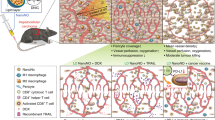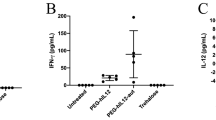Abstract
Mutation of the p53 tumor suppressor gene, the most common genetic alteration in human cancers, results in more aggressive disease and increased resistance to conventional therapies. Aggressiveness may be related to the increased angiogenic activity of cancer cells containing mutant p53. To restore wild-type p53 function in cancer cells, we developed polymeric nanoparticles (NPs) for p53 gene delivery. Previous in vitro and in vivo studies demonstrated the ability of these NPs to provide sustained intracellular release of DNA, thus sustained gene transfection and decreased tumor cell proliferation. We investigated in vivo mechanisms involved in NP-mediated p53 tumor inhibition, with focus on angiogenesis. We hypothesize that sustained p53 gene delivery will help decrease tumor angiogenic activity and thus reduce tumor growth and improve animal survival. Xenografts of p53 mutant tumors were treated with a single intratumoral injection of p53 gene-loaded NPs (p53NPs). We observed intratumoral p53 gene expression corresponding to tumor growth inhibition, over 5 weeks. Treated tumors showed upregulation of thrombospondin-1, a potent antiangiogenic factor, and a decrease in microvessel density vs controls (saline, p53 DNA alone, and control NPs). Greater levels of apoptosis were also observed in p53NP-treated tumors. Overall, this led to significantly improved survival in p53NP-treated animals. NP-mediated p53 gene delivery slowed cancer progression and improved survival in an in vivo cancer model. One mechanism by which this was accomplished was disruption of tumor angiogenesis. We conclude that the NP-mediated sustained tumor p53 gene therapy can effectively be used for tumor growth inhibition.
This is a preview of subscription content, access via your institution
Access options
Subscribe to this journal
Receive 12 print issues and online access
$259.00 per year
only $21.58 per issue
Buy this article
- Purchase on Springer Link
- Instant access to full article PDF
Prices may be subject to local taxes which are calculated during checkout







Similar content being viewed by others
References
Vogelstein B, Kinzler KW . p53 function and dysfunction. Cell 1992; 70: 523–526.
Vogelstein B, Lane D, Levine AJ . Surfing the p53 network. Nature 2000; 408: 307–310.
Brosh R, Rotter V . When mutants gain new powers: news from the mutant p53 field. Nat Rev Cancer 2009; 9: 701–713.
Carson DA, Lois A . Cancer progression and p53. Lancet 1995; 346: 1009–1011.
Olivier M, Petitjean A, Marcel V, Petre A, Mounawar M, Plymoth A et al. Recent advances in p53 research: an interdisciplinary perspective. Cancer Gene Ther 2009; 16: 1–12.
Brown CJ, Lain S, Verma CS, Fersht AR, Lane DP . Awakening guardian angels: drugging the p53 pathway. Nat Rev Cancer 2009; 9: 862–873.
Dameron KM, Volpert OV, Tainsky MA, Bouck N . The p53 tumor suppressor gene inhibits angiogenesis by stimulating the production of thrombospondin. Cold Spring Harb Symp Quant Biol 1994; 59: 483–489.
Gasparini G, Weidner N, Bevilacqua P, Maluta S, Dalla Palma P, Caffo O et al. Tumor microvessel density, p53 expression, tumor size, and peritumoral lymphatic vessel invasion are relevant prognostic markers in node-negative breast carcinoma. J Clin Oncol 1994; 12: 454–466.
Yu EY, Yu E, Meyer GE, Brawer MK . The relation of p53 protein nuclear accumulation and angiogenesis in human prostatic carcinoma. Prostate Cancer Prostatic Dis 1997; 1: 39–44.
Xu M, Kumar D, Srinivas S, Detolla LJ, Yu SF, Stass SA et al. Parenteral gene therapy with p53 inhibits human breast tumors in vivo through a bystander mechanism without evidence of toxicity. Hum Gene Ther 1997; 8: 177–185.
Bouvet M, Ellis LM, Nishizaki M, Fujiwara T, Liu W, Bucana CD et al. Adenovirus-mediated wild-type p53 gene transfer down-regulates vascular endothelial growth factor expression and inhibits angiogenesis in human colon cancer. Cancer Res 1998; 58: 2288–2292.
Prabha S, Labhasetwar V . Nanoparticle-mediated wild-type p53 gene delivery results in sustained antiproliferative activity in breast cancer cells. Mol Pharmaceutics 2004; 1: 211–219.
Sharma B, Ma W, Adjei IM, Panyam J, Dimitrijevic S, Labhasetwar V . Nanoparticle-mediated p53 gene therapy for tumor inhibition. Drug Deliv Transl Res 2011; 1: 43–52.
Ditto AJ, Shah PN, Yun YH . Non-viral gene delivery using nanoparticles. Expert Opin Drug Deliv 2009; 6: 1149–1160.
Seki M, Iwakawa J, Cheng H, Cheng PW . p53 and PTEN/MMAC1/TEP1 gene therapy of human prostate PC-3 carcinoma xenograft, using transferrin-facilitated lipofection gene delivery strategy. Hum Gene Ther 2002; 13: 761–773.
Prabha S, Labhasetwar V . Critical determinants in PLGA/PLA nanoparticle-mediated gene expression. Pharm Res 2004; 21: 354–364.
Vasir J, Labhasetwar V . Biodegradable Nanoparticles In Gene Transfer: Delivery and Expression of DNA and RNA. A Laboratory Manual, Cold Spring Harbor Laboratory Press: Woodbury NY, 2006.
Labhasetwar V, Bonadio J, Goldstein S, Chen W, Levy RJ . A DNA controlled-release coating for gene transfer: transfection in skeletal and cardiac muscle. J Pharm Sci 1998; 87: 1347–1350.
Labhasetwar VJB, Goldstein S, Levy RJ . Gene transfection using biodegradable nanospheres: results in tissue culture and a rat osteotomy model. Colloids Surf B Biointerfaces 1999; 16: 281–290.
Panyam J, Zhou WZ, Prabha S, Sahoo SK, Labhasetwar V . Rapid endo-lysosomal escape of poly(D,L-lactide-co-glycolide) nanoparticles: implications for drug and gene delivery. FASEB J 2002; 16: 1217–1226.
Lacroix M, Toillon RA, Leclercq G . p53 and breast cancer, an update. Endocr Relat Cancer 2006; 13: 293–325.
Weidner N, Semple JP, Welch WR, Folkman J . Tumor angiogenesis and metastasis--correlation in invasive breast carcinoma. N Engl J Med 1991; 324: 1–8.
Dings RP, Van Laar ES, Loren M, Webber J, Zhang Y, Waters SJ et al. Inhibiting tumor growth by targeting tumor vasculature with galectin-1 antagonist anginex conjugated to the cytotoxic acylfulvene, 6-hydroxylpropylacylfulvene. Bioconjug Chem 2010; 21: 20–27.
Zhang S, Li Y, Li L, Zhang Y, Gao N, Zhang Z et al. Phase I study of repeated intraepithelial delivery of adenoviral p53 in patients with dysplastic oral leukoplakia. J Oral Maxillofac Surg 2009; 67: 1074–1082.
Cristofanilli M, Krishnamurthy S, Guerra L, Broglio K, Arun B, Booser DJ et al. A nonreplicating adenoviral vector that contains the wild-type p53 transgene combined with chemotherapy for primary breast cancer: safety, efficacy, and biologic activity of a novel gene-therapy approach. Cancer 2006; 107: 935–944.
Nakase M, Inui M, Okumura K, Kamei T, Nakamura S, Tagawa T . p53 gene therapy of human osteosarcoma using a transferrin-modified cationic liposome. Mol Cancer Ther 2005; 4: 625–631.
Pisters LL, Pettaway CA, Troncoso P, McDonnell TJ, Stephens LC, Wood CG et al. Evidence that transfer of functional p53 protein results in increased apoptosis in prostate cancer. Clin Cancer Res 2004; 10: 2587–2593.
Heilbronn R, Weger S . Viral vectors for gene transfer: current status of gene therapeutics. Handb Exp Pharmacol 2010; 197): 143–170.
Nyberg P, Xie L, Kalluri R . Endogenous inhibitors of angiogenesis. Cancer Res 2005; 65: 3967–3979.
Zabrenetzky V, Harris CC, Steeg PS, Roberts DD . Expression of the extracellular matrix molecule thrombospondin inversely correlates with malignant progression in melanoma, lung and breast carcinoma cell lines. Int J Cancer 1994; 59: 191–195.
Xu M, Kumar D, Stass SA, Mixson AJ . Gene therapy with p53 and a fragment of thrombospondin I inhibits human breast cancer in vivo. Mol Genet Metab 1998; 63: 103–109.
Li L, Leedom TA, Do J, Huang H, Lai J, Johnson K et al. Antitumor efficacy of a thrombospondin 1 mimetic CovX-body. Transl Oncol 2011; 4: 249–257.
van Eekelen M, Sasportas LS, Kasmieh R, Yip S, Figueiredo JL, Louis DN et al. Human stem cells expressing novel TSP-1 variant have anti-angiogenic effect on brain tumors. Oncogene 2010; 29: 3185–3195.
Dameron KM, Volpert OV, Tainsky MA, Bouck N . Control of angiogenesis in fibroblasts by p53 regulation of thrombospondin-1. Science 1994; 265: 1582–1584.
Gautam A, Densmore CL, Melton S, Golunski E, Waldrep JC . Aerosol delivery of PEI-p53 complexes inhibits B16-F10 lung metastases through regulation of angiogenesis. Cancer Gene Ther 2002; 9: 28–36.
Chen QR, Mixson AJ . Systemic gene therapy with p53 inhibits breast cancer: recent advances and therapeutic implications. Front Biosci 1998; 3: D997–D1004.
Vousden KH, Lu X . Live or let die: the cell's response to p53. Nat Rev Cancer 2002; 2: 594–604.
Chen X, Ko LJ, Jayaraman L, Prives C . p53 levels, functional domains, and DNA damage determine the extent of the apoptotic response of tumor cells. Genes Dev 1996; 10: 2438–2451.
Acknowledgements
This study was funded by grant 1R01 EB 003975 from the National Institute of Biomedical Imaging and Bioengineering of the National Institutes of Health (to VL). SP was supported by a predoctoral fellowship from the Department of Defense, US Army Medical Research and Materiel Command (DAMD17–02–1–0506).
Author information
Authors and Affiliations
Corresponding author
Ethics declarations
Competing interests
The authors declare no conflict of interest.
Rights and permissions
About this article
Cite this article
Prabha, S., Sharma, B. & Labhasetwar, V. Inhibition of tumor angiogenesis and growth by nanoparticle-mediated p53 gene therapy in mice. Cancer Gene Ther 19, 530–537 (2012). https://doi.org/10.1038/cgt.2012.26
Received:
Revised:
Accepted:
Published:
Issue Date:
DOI: https://doi.org/10.1038/cgt.2012.26
Keywords
This article is cited by
-
TP53 to mediate immune escape in tumor microenvironment: an overview of the research progress
Molecular Biology Reports (2024)
-
In vivo evaluation of biodistribution and toxicity of pH-responsive strontium nanoparticles for gene delivery
Journal of Pharmaceutical Investigation (2022)
-
Recent advances of nanotechnology-based tumor vessel-targeting strategies
Journal of Nanobiotechnology (2021)
-
Highly specific in vivo gene delivery for p53-mediated apoptosis and genetic photodynamic therapies of tumour
Nature Communications (2015)
-
Attenuated Total Reflectance Fourier Transform Infrared Spectroscopy: An analytical technique to understand therapeutic responses at the molecular level
Scientific Reports (2015)



